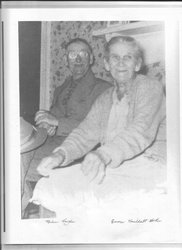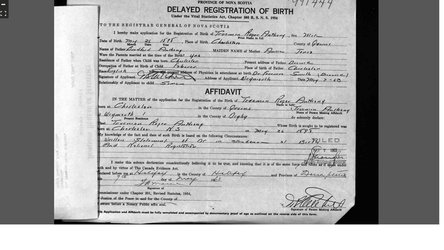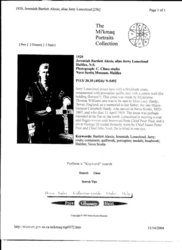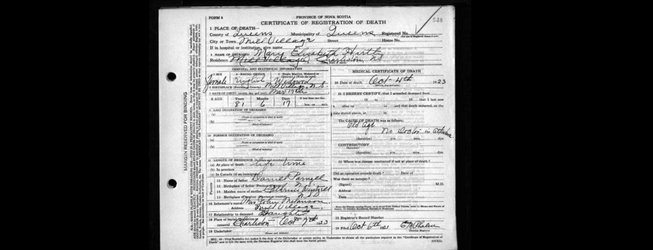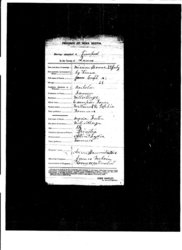All percentages on website are for my own Calculations and do not have anything to do with being able to be eligible as native. The use of 6(1) etc are also what I believe to be true and in no way is connected to either the Nova Scotia Native Council or the dept of Indian and Northern Affairs. If proven otherwise I will make corrections as information, backed up by documents become available.
This website is for my own use but I will allow anybody access with the understanding that, as anybody that does the same research will understand, information may at times be incorrect due to the lack of access to documentation.
I have and always will try to provide sources that I have used and take no responsibility if that information has been altered. Any and all feedback is welcomed. Please submit any requests for records here.
Below is the source used for the use of 6(1) etc.
The New Math of the New Indian Act: 6(2)+6(2)=6(1)
Professor D.N. Sprague
Native Studies Review, Vol. 10, No. 1, 1995, pp. 47-60.
( The University of Saskatchewan, one of Canada's top research universities ) Page 49 of the above document reads as follows:
A significant adjustment of the Indian Act did occur in 1985; the government intended to remove the gender bias by transferring the sanction imposed on Indian women to the children of mixed marriages. Under the new act , any person ( male or female ) could marry a non-Indian without prejudice to his or her own status, but the children of such unions are disqualified from passing Indian status on to their children - unless they marry partners entitled to be registered as Indians. The new act identifies two categories of Indian persons depending on their parentage: Indian people of Indian parentage ( section 6(1) Indians ) and Indian people of mixed parentage ( section 6(2) Indians ) And since the parentage test can be extended genealogy back to the beginning of recorded history, persons can be deemed to have been registered - counted as registered - if they would have been entitled to such enrollment by the criteria in effect at the time, even if such persons were not in fact registered. By the " deeming provisions " the Aboriginality of Metis people as well as non-status Indians seems admitted; individuals in both categories may assert their Aboriginality as equivalent to " Indian " if
6(1) - both parents Indian
6(2) - one parent Indian
6(1)+6(1)=6(1)
6(1)+6(2)=6(1)
6(2)+6(2)=6(1)
6(2)+ non-Indian= 6(2)
but
6(2)+ non-Indian= Matis
Just a comment on the above line "since the parentage test can be extended genealogy back to the beginning of recorded history" and only because of a new ruling by the Supreme Court of Canada. The following is a decision made by Chief Justice Lamar of the Supreme Court of Canada where he concluded that the laws of evidence must be adapted in order that oral evidence can be accommodated and placed on an equal footing with the types of historical evidence that courts are familiar with, which largely consists of historical documents.
To quote Dickson C.L. ( appointed the 15th Chief Justice of Canada on April 18, 1984.) given that most aboriginal societies did not keep written records the failure to do so would impose an impossible burden of proof on aboriginal peoples and render nugatory any rights that they have. ( Simon v. The Queen, [1985] 2 C.R. 387 at p. 408 ) This process must be undertaken on a case-by-case basis.
As an example Allen Glode Foster was reputedly a Micmac Indian. One version of the oral record claims Allen was native but there is no real solid evidence to back that claim as far as any written records that have been discovered or that have been brought forward. So the only proof provided so far that supports that claim is in the form of Mi'kmaq oral histories and narratives which is well within the rights of that community.
Another lesser known example that should be taking into consideration is John Pennall from Gold River who was reputedly a Micmac Indian. The Parnell and the Hirtle families both have had an oral tradition ( the transmission of customs or beliefs from generation to generation, or the fact of being passed on in this way and one that most people in the Charleston area would not discuss ) that states that their family lines also includes John Pennall which has been ignored or has been denied outright by other groups or social organizations.
Now with the information that I have provided, backed up with documentation,( Nova Scotia VitalRecords, Nova Scotia Deaths, Nova Scotia Delayed Births, Nova Scotia Marriages,and Canada Census records ) there should be more than enough evidence to support the John Pennall claim or at least to have the naysayers prove the opposite beyond any doubt following the same standards that I have used. Names within reason, location and timeline, some kind of documentation that has a least 2 or more pieces of reləvənt information that points to the name in question. One question that always seems to come up concerning John Pennall is why he changed his name and why it was that growing up in the Charleston area that there was never any mention of the fact that there was a connection to the Micmacs. I guess the best way to answer or at least to try and provide a logicical answer is to start with following:
L. F. S. UPTON
Indian Policy
in Colonial Nova Scotia
1783 -1871
The Micmacs had done their best to maintain a traditional way of life that every year returned them a lower level of subsistence. Successive humanitarians and officials had presented them with the same alternative to their endemic poverty: become like the whites, till the soil, forget their Indian ways. They refused to farm on reserves that were too small for any other use. They were still perpetually on the move, restricted to no particular territory, roaming at will over Crown Lands and white owned farms and through the towns and villages. They had incorporated the whites into their seasonal cycle of life to the extent that they employed themselves as itinerant peddlers in the summer, but they could not cope with winter, for which they were dependent on relief from provincial and local funds. Their numbers had begun to increase from the low point of the famine years, although they remained a tiny minority in their own homeland: there were four times as many blacks as Indians in Nova Scotia in 1860. The Micmacs were the poorest of the poor, classified as a group along with paupers and without basic civil rights.
Daniel N. Paul
September 9, 1994 Halifax Herald
Tragic after-effects of centuries of racist persecution
a quote from that column
A well-respected African Nova Scotian columnist wrote me a letter earlier this year and I quote from it the following:
“Several years ago, I watched a panel discussion that had several minority members, including a Black and a Micmac...the Micmac representative said that Blacks were slaves in the early days of European colonization, but his people were lower than slaves...At that time, I didn't understand what he meant. What, I wondered, is lower than being a piece of property to be bought and sold like a horse or cow?...Then, in the chapter of your book titled "The Edge of Extinction," I read about how your people were systematically starved to death. At least a slave gets fed, simply because the owner has a vested interest in keeping him or her alive to maintain the slave's value as property...So, thanks to you, I know what it is to be "lower than a slave" - to not even have value as human chattel or property...I know I'll learn more as I finish the book. Right now, though, I'd recommend that it be required reading in all Nova Scotia schools.” - Charles Saunders, February 2, 1994.
Now taking these two submissions into consideration , one from a white side and one from a native view and both basically stating the same, that at least explains the situation at that time which would explain the name change, and also explain why the subject was never talked about when I was growing up.
Again to quote Daniel N. Paul from the same column:
To suffer being treated without respect and the barest traces of human decency is the most humiliating experience a human being can suffer. A White friend once told me he knew how I felt being denied. I responded that, no, he didn't. There is no way to describe how it feels to be debased by racism. To be arrested and shoved in jail for drinking one bottle of beer, to be denied citizenship and the right to vote in your own country's elections, to be barred from establishments and institutions, etc., all because of what you are - a native person - and not what you did is an humiliating experience that no human should ever have to suffer.



